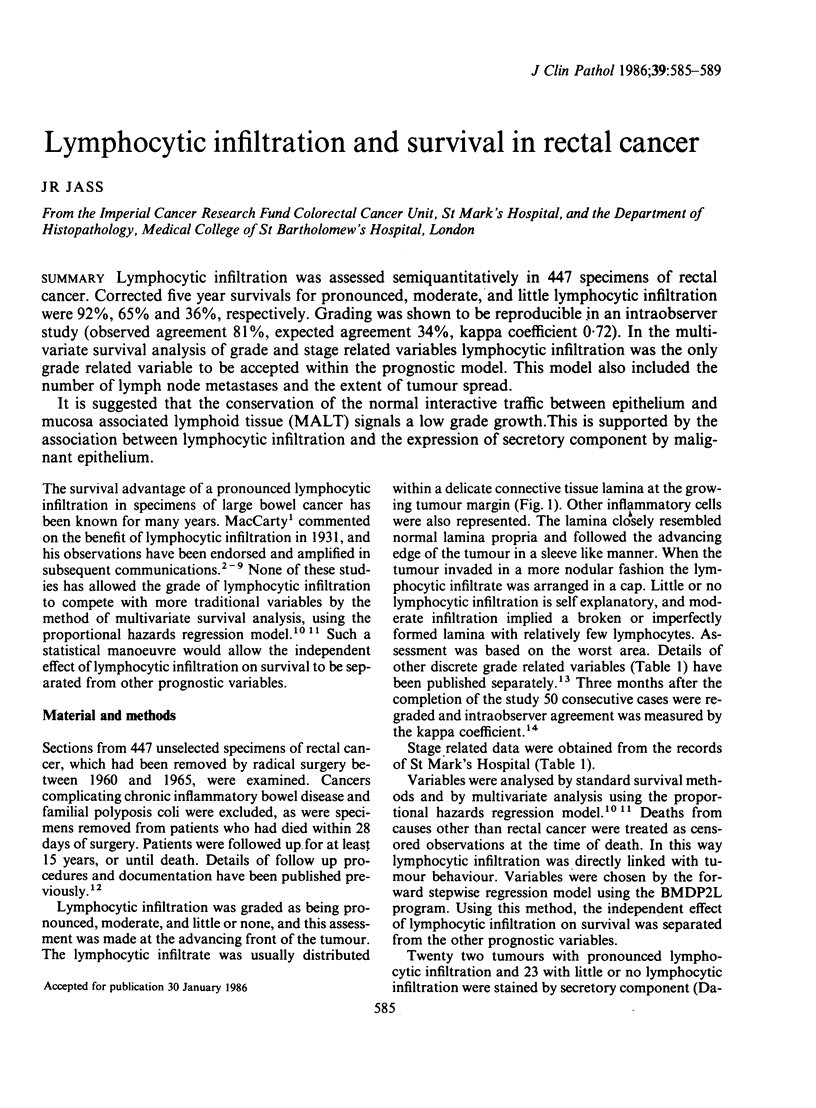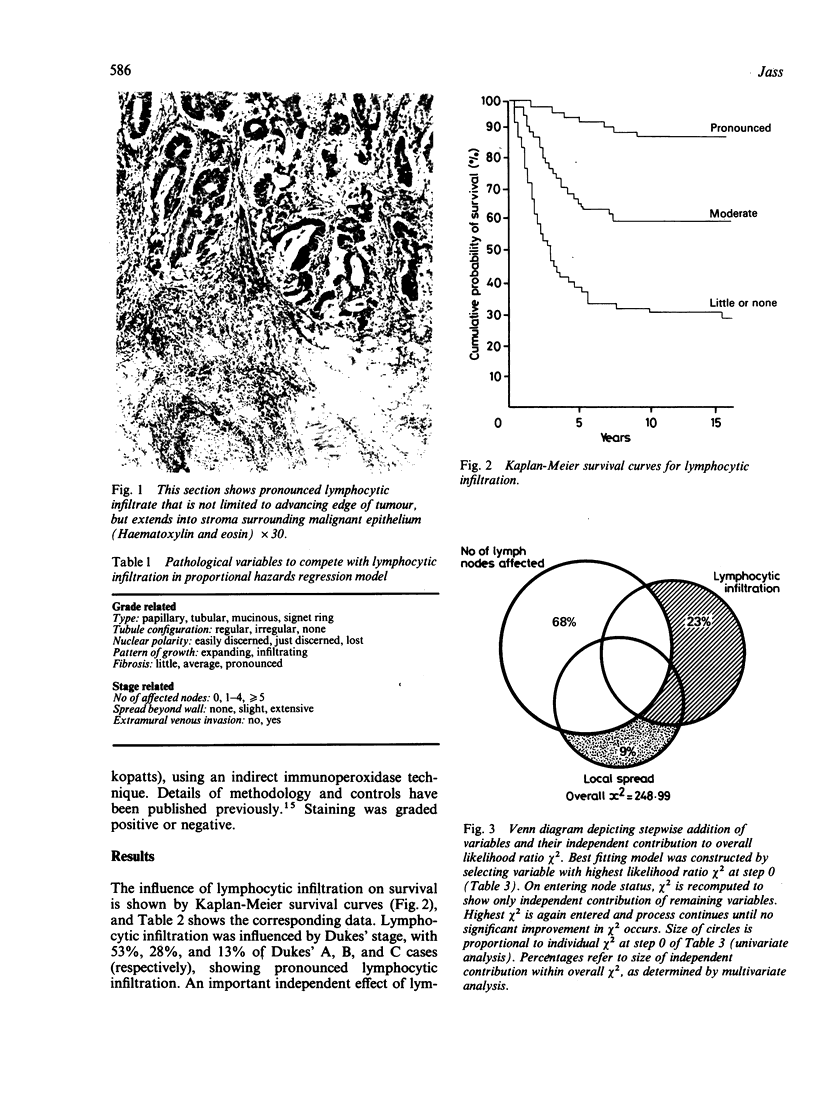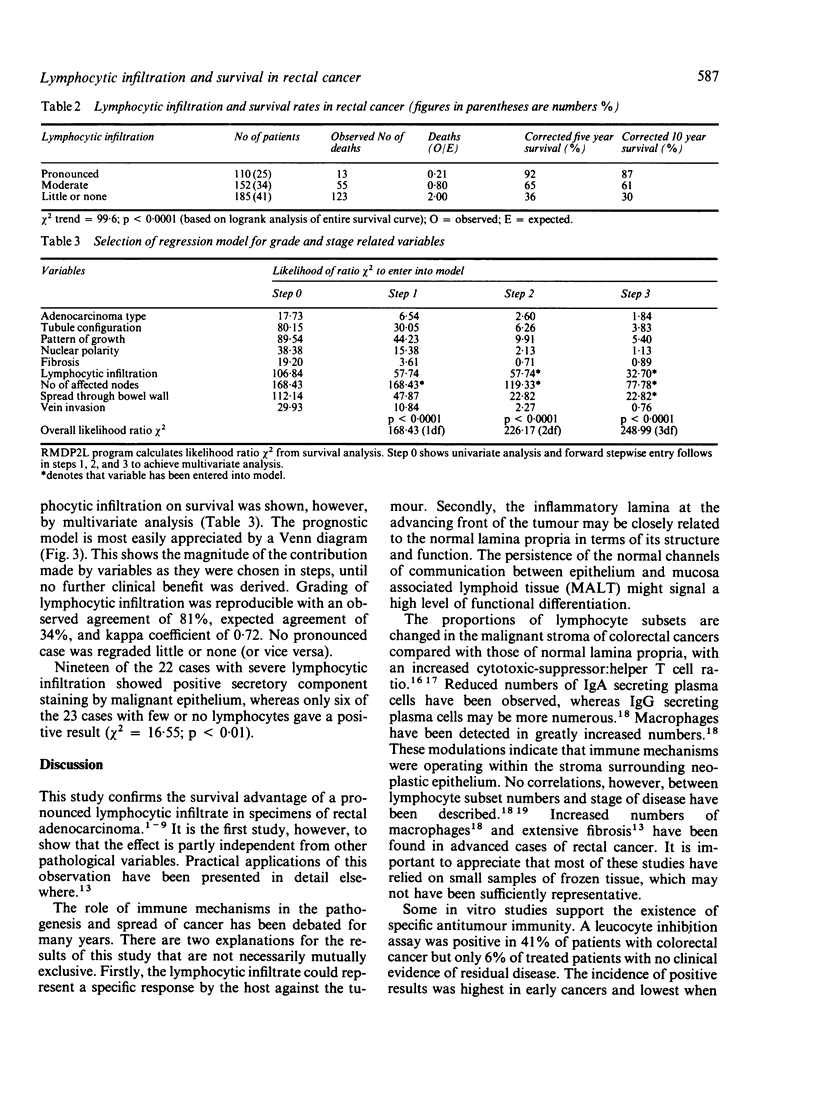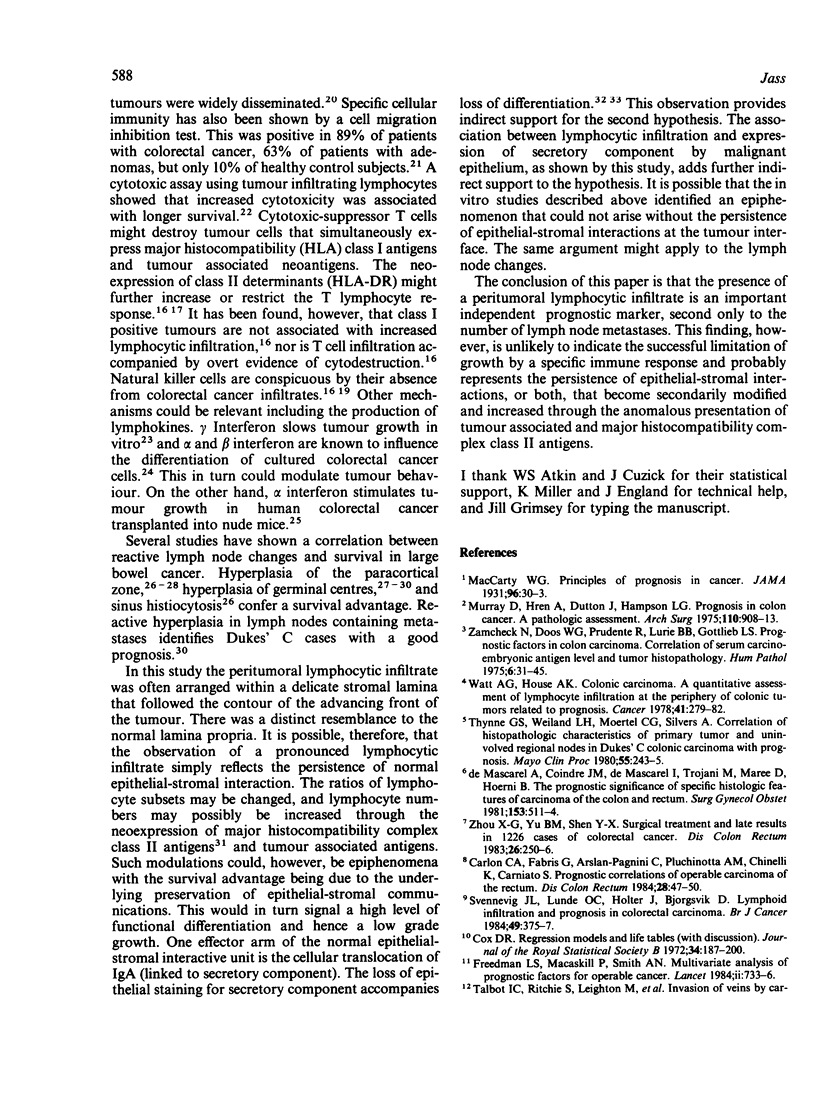Abstract
Lymphocytic infiltration was assessed semiquantitatively in 447 specimens of rectal cancer. Corrected five year survivals for pronounced, moderate, and little lymphocytic infiltration were 92%, 65% and 36%, respectively. Grading was shown to be reproducible in an intraobserver study (observed agreement 81%, expected agreement 34%, kappa coefficient 0.72). In the multivariate survival analysis of grade and stage related variables lymphocytic infiltration was the only grade related variable to be accepted within the prognostic model. This model also included the number of lymph node metastases and the extent of tumour spread. It is suggested that the conservation of the normal interactive traffic between epithelium and mucosa associated lymphoid tissue (MALT) signals a low grade growth. This is supported by the association between lymphocytic infiltration and the expression of secretory component by malignant epithelium.
Full text
PDF




Images in this article
Selected References
These references are in PubMed. This may not be the complete list of references from this article.
- Allen C., Hogg N. Monocytes and other infiltrating cells in human colorectal tumours identified by monoclonal antibodies. Immunology. 1985 Jun;55(2):289–299. [PMC free article] [PubMed] [Google Scholar]
- Arends J. W., Wiggers T., Thijs C. T., Verstijnen C., Swaen G. J., Bosman F. T. The value of secretory component (SC) immunoreactivity in diagnosis and prognosis of colorectal carcinomas. Am J Clin Pathol. 1984 Sep;82(3):267–274. doi: 10.1093/ajcp/82.3.267. [DOI] [PubMed] [Google Scholar]
- Armstrong C. A., Klostergaard J., Granger G. A. Isolation and initial characterization of tumoricidal monokine(s) from the human monocytic leukemia cell line THP-1. J Natl Cancer Inst. 1985 Jan;74(1):1–9. [PubMed] [Google Scholar]
- Carlon C. A., Fabris G., Arslan-Pagnini C., Pluchinotta A. M., Chinelli E., Carniato S. Prognostic correlations of operable carcinoma of the rectum. Dis Colon Rectum. 1985 Jan;28(1):47–50. doi: 10.1007/BF02553907. [DOI] [PubMed] [Google Scholar]
- Csiba A., Whitwell H. L., Moore M. Distribution of histocompatibility and leucocyte differentiation antigens in normal human colon and in benign and malignant colonic neoplasms. Br J Cancer. 1984 Nov;50(5):699–709. doi: 10.1038/bjc.1984.239. [DOI] [PMC free article] [PubMed] [Google Scholar]
- Fink A., Shani A., Weisman Z., Wechsler U., Pfeffermann R., Harpaz N., Eitan S., Bentwich Z. Leukocyte adherence inhibition (LAI) for detecting specific tumor immunity in colorectal cancer. Immunol Lett. 1985;9(2-3):143–147. doi: 10.1016/0165-2478(85)90025-2. [DOI] [PubMed] [Google Scholar]
- Freedman L. S., Macaskill P., Smith A. N. Multivariate analysis of prognostic factors for operable rectal cancer. Lancet. 1984 Sep 29;2(8405):733–736. doi: 10.1016/s0140-6736(84)92636-9. [DOI] [PubMed] [Google Scholar]
- Isaacson P. Immunoperoxidase study of the secretory immunoglobulin system in colonic neoplasia. J Clin Pathol. 1982 Jan;35(1):14–25. doi: 10.1136/jcp.35.1.14. [DOI] [PMC free article] [PubMed] [Google Scholar]
- Jass J. R., Faludy J. Immunohistochemical demonstration of IgA and secretory component in relation to epithelial cell differentiation in normal colorectal mucosa and metaplastic polyp: a semiquantitative study. Histochem J. 1985 Mar;17(3):373–380. doi: 10.1007/BF01004598. [DOI] [PubMed] [Google Scholar]
- Koch B., Giedl J., Hermanek P., Kalden J. R. The analysis of mononuclear cell infiltrations in colorectal adenocarcinoma. J Cancer Res Clin Oncol. 1985;109(2):142–151. doi: 10.1007/BF00391889. [DOI] [PMC free article] [PubMed] [Google Scholar]
- Lampert I. A., Kirkland S., Farrell S., Borysiewicz L. K. HLA-DR expression in a human colonic carcinoma cell line. J Pathol. 1985 Aug;146(4):337–344. doi: 10.1002/path.1711460407. [DOI] [PubMed] [Google Scholar]
- Landis J. R., Koch G. G. The measurement of observer agreement for categorical data. Biometrics. 1977 Mar;33(1):159–174. [PubMed] [Google Scholar]
- Murray D., Hreno A., Dutton J., Hampson L. G. Prognosis in colon cancer: a pathologic reassessment. Arch Surg. 1975 Aug;110(8):908–913. doi: 10.1001/archsurg.1975.01360140052011. [DOI] [PubMed] [Google Scholar]
- Patt D. J., Brynes R. K., Vardiman J. W., Coppleson L. W. Mesocolic lymph node histology is an important prognostic indicator for patients with carcinoma of the sigmoid colon: an immunomorphologic study. Cancer. 1975 May;35(5):1388–1396. doi: 10.1002/1097-0142(197505)35:5<1388::aid-cncr2820350523>3.0.co;2-g. [DOI] [PubMed] [Google Scholar]
- Pihl E., Malahy M. A., Khankhanian N., Hersh E. M., Mavligit G. M. Immunomorphological features of prognostic significance in Dukes' Class B colorectal carcinoma. Cancer Res. 1977 Nov;37(11):4145–4149. [PubMed] [Google Scholar]
- Pihl E., Nairn R. C., Milne B. J., Cuthbertson A. M., Hughes E. S., Rollo A. Lymphoid hyperplasia: a major prognostic feature in 519 cases of colorectal carcinoma. Am J Pathol. 1980 Aug;100(2):469–480. [PMC free article] [PubMed] [Google Scholar]
- Pihl E., Nairn R. C., Nind A. P., Muller H. K., Hughes E. S., Cuthbertson A. M., Rollo A. J. Correlation of regional lymph node in vitro antitumor immunoreactivity histology with colorectal carcinoma. Cancer Res. 1976 Oct;36(10):3665–3671. [PubMed] [Google Scholar]
- Schwartz R., Momburg F., Moldenhauer G., Dörken B., Schirrmacher V. Induction of HLA class-II antigen expression on human carcinoma cell lines by IFN-Gamma. Int J Cancer. 1985 Feb 15;35(2):245–250. doi: 10.1002/ijc.2910350217. [DOI] [PubMed] [Google Scholar]
- Svennevig J. L., Lunde O. C., Holter J., Bjørgsvik D. Lymphoid infiltration and prognosis in colorectal carcinoma. Br J Cancer. 1984 Mar;49(3):375–377. doi: 10.1038/bjc.1984.60. [DOI] [PMC free article] [PubMed] [Google Scholar]
- Talbot I. C., Ritchie S., Leighton M., Hughes A. O., Bussey H. J., Morson B. C. Invasion of veins by carcinoma of rectum: method of detection, histological features and significance. Histopathology. 1981 Mar;5(2):141–163. doi: 10.1111/j.1365-2559.1981.tb01774.x. [DOI] [PubMed] [Google Scholar]
- Thynne G. S., Weiland L. H., Moertel C. G., Silvers A. Correlation of histopathologic characteristics of primary tumor and uninvolved regional lymph nodes in Dukes' class C colonic carcinoma with prognosis. Mayo Clin Proc. 1980 Apr;55(4):243–245. [PubMed] [Google Scholar]
- Tsakraklides V., Wanebo H. J., Sternberg S. S., Stearns M., Good R. A. Prognostic evaluation of regional lymph node morphology colorectal cancer. Am J Surg. 1975 Feb;129(2):174–180. doi: 10.1016/0002-9610(75)90294-9. [DOI] [PubMed] [Google Scholar]
- Watt A. G., House A. K. Colonic carcinoma: a quantitative assessment of lymphocyte infiltration at the periphery of colonic tumors related to prognosis. Cancer. 1978 Jan;41(1):279–282. doi: 10.1002/1097-0142(197801)41:1<279::aid-cncr2820410139>3.0.co;2-b. [DOI] [PubMed] [Google Scholar]
- Zamcheck N., Doos W. G., Prudente R., Lurie B. B., Gottlieb L. S. Prognostic factors in colon carcinoma: correlation of serum carcinoembryonic antigen level and tumor histopathology. Hum Pathol. 1975 Jan;6(1):31–45. doi: 10.1016/s0046-8177(75)80108-0. [DOI] [PubMed] [Google Scholar]
- Zhou X. G., Yu B. M., Shen Y. X. Surgical treatment and late results in 1226 cases of colorectal cancer. Dis Colon Rectum. 1983 Apr;26(4):250–256. doi: 10.1007/BF02562491. [DOI] [PubMed] [Google Scholar]



